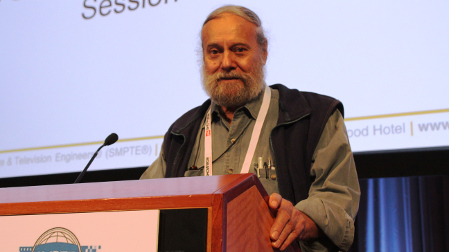SMPTE 2015: ‘Resurrecting the Restored:’ Imaging Technology From the Past, Present, for the Future
HOLLYWOOD, CALIF.-Wednesday's "Resurrecting the Restored" sessions each studied, from different perspectives, how the past, present and future of imaging continue to intertwine and intersect—from the frame rates of the 1895 Thomas Edison film "Anna Belle Serpentine Dance" evaluated in the first paper to the high dynamic range (HDR) projection of the just-released Ridley Scott film The Martian advocated in the final one.

Jonathan Erland
In "The Digital Projection of Silent Era Films," Jonathan Erland detailed recent research projects underway at the Pickfair Institute, including how to transfer silent films designed for projection at 16, 18 or 22 frames per second (as well as the standard 24) to digital formats while maintaining the original intentions of the creators. (Erland showed a sample of director D.W. Griffith's detailed instructions to projectionists on the varying, hand-cranked speeds required for each reel of his film “Home Sweet Home.”)
The founder of the Pickfair Institute for Cinematic Studies, Erland created the Digital Projection of Archival Films Project as an ad hoc special interest group to facilitate the digital projection of archive films in their original frame rates.
"The mere existence of a standard defining, say, 16 frames per second, doesn't necessarily provide a way to deliver that frame rate," Erland emphasized. "Given the current preoccupation of the motion picture community with the high frame rate (HFR) demands of 3D presentation as voiced by such as Peter Jackson, Doug Trumbull and James Cameron, the provision of enabling technology for the 'orphan' rates associated with archive films has been given short shrift.
"Our project actually seeks to take advantage of the expanding emphasis on high frame rates to achieve our goal of providing frame rates below the 20-frame DLP Cinema minimum," he continued. "We do this by including the shutter blanking intervals as 'frames' or 'pulses.' Thus, a 16-frame film is projected by the digital projector as 96 'pulses' or, three image flashes and three blank pulses for each 16-frame per second image, much as the period projector technology did with the multiple blades of the projector shutter."
Erland showed several versions of French silent film "The Dancing Pig," demonstrating the "pulses" used to emulate 16fps. "We project frame one as a discrete frame for 10 milliseconds, followed by the projection of 10 milliseconds of black," he explained, "followed by the continued projection of frame one and another similar period of black with yet another projection of frame one and black. We now project frame two and follow the same sequence as before.
"We believe this work will be a significant achievement in an age in which it will be prohibitive to project actual film prints," he concluded, "and vital for a museum, such as the one the Academy [of Motion Picture Arts and Sciences] is planning, where the need will be for literally thousands, indeed essentially continuous, presentations."
James Snyder underscored many of the concepts introduced in Erland's presentation with his talk, "The Challenges of Media Archiving Past & Future," particularly the need to continuously update archival, management and transfer strategies: "Digital files are the future," he said, "and they're also the past."
Snyder, the senior systems administrator for the Library of Congress' National Audio-Visual Conservation Center (NAVCC), is concerned with long-term preservation plans and how, as he said, "not to make mistakes with future collections," as the quantity and diversity of content continues to grow. ("That's why, when I see the AR and VR demonstrations," he laughed, "they give me heartburn.")
Advocating sensible, "good, long-term choices," Snyder reminded the audience to "plan for change and obsolescence," adding, "You have to get used to migration."
The world's archive and research institution, The Library of Congress migrates its data every three-to-seven years. Currently, the LOC's Motion Picture, Broadcasting & Recorded Sound Division maintains over 7,000,000 items, including more than 1,000,000 video tapes using almost every format known, and over 3,000,000 audio recordings, also of almost every format known.
Snyder also stressed documentation and metadata as invaluable tools for handing over media to future generations: "Discoverability means use."
Preparing for the future is a goal shared by Deluxe OnDemand's Vice President, Solutions Engineering Ken Goeller. Goeller's presentation "Building the HDR Economy Nit by Nit," examined the factors impacting the demand for what he termed "transformative" content to be viewed using newly developed HDR projectors or on HDR displays.
The emergence of HDR technology has captivated the film and television industries, Goeller explained, and signals an opportunity to deliver a far more compelling viewing experience to theaters, the living room big screen and an array of small screens.
"Among content providers, HDR represents the most exciting format to come along since color TV," he said. "Unlike the UHD format, which is primarily consumed on the large screen in the home, HDR provides a never-before-seen increase in contrast, color and luminance across all screens. Theaters are being outfitted with HDR projectors, first-run features such as 20th Century Fox's “The Martian” are being released in HDR, and live sports broadcasting in HDR has been announced. And more importantly, HDR is likely to feed Hollywood's appetite to access, repurpose and monetize their existing content libraries.
"The entertainment industry will need to begin supporting HDR sooner than later," Goeller predicted, "before standards issues are resolved."
Get the TV Tech Newsletter
The professional video industry's #1 source for news, trends and product and tech information. Sign up below.
